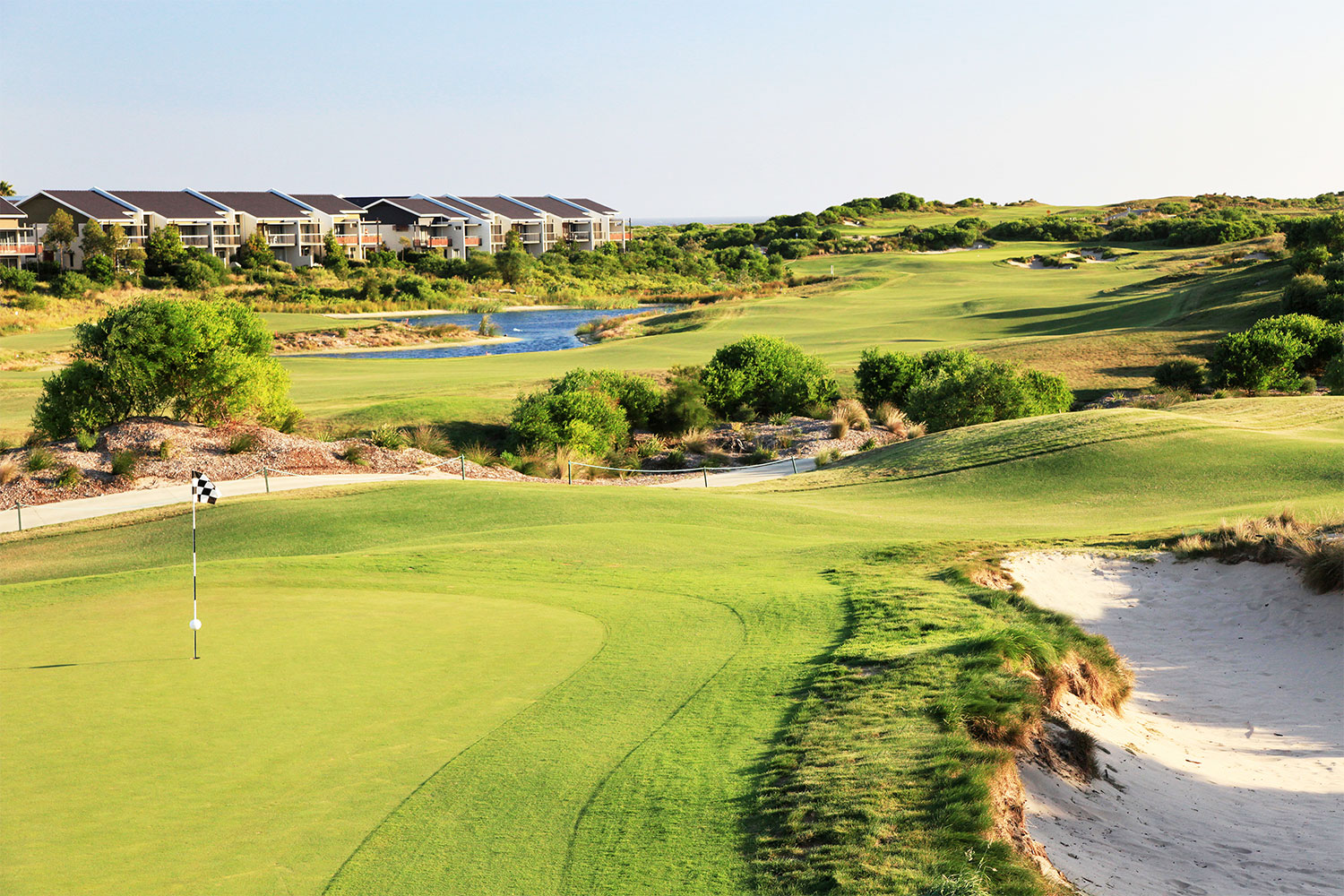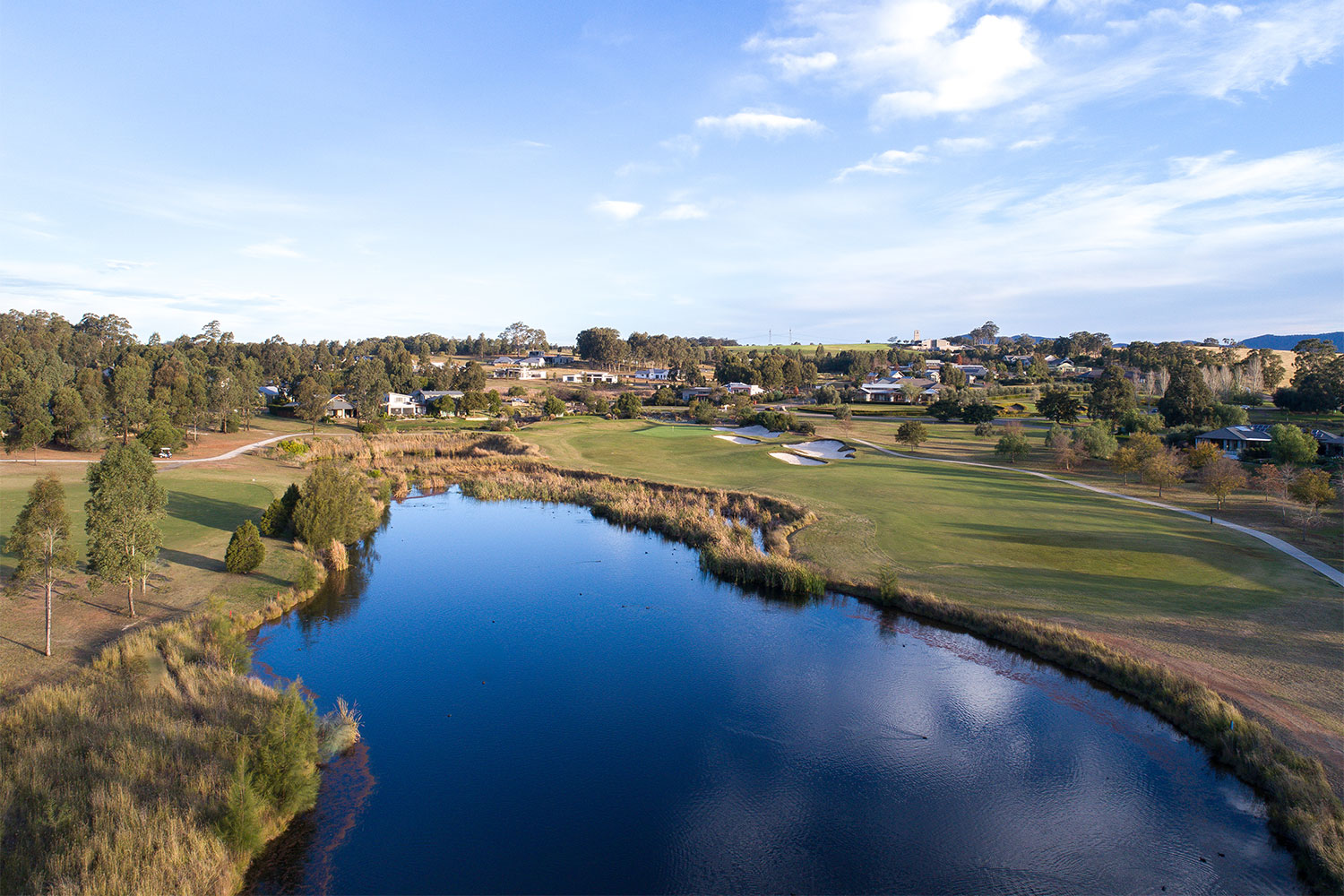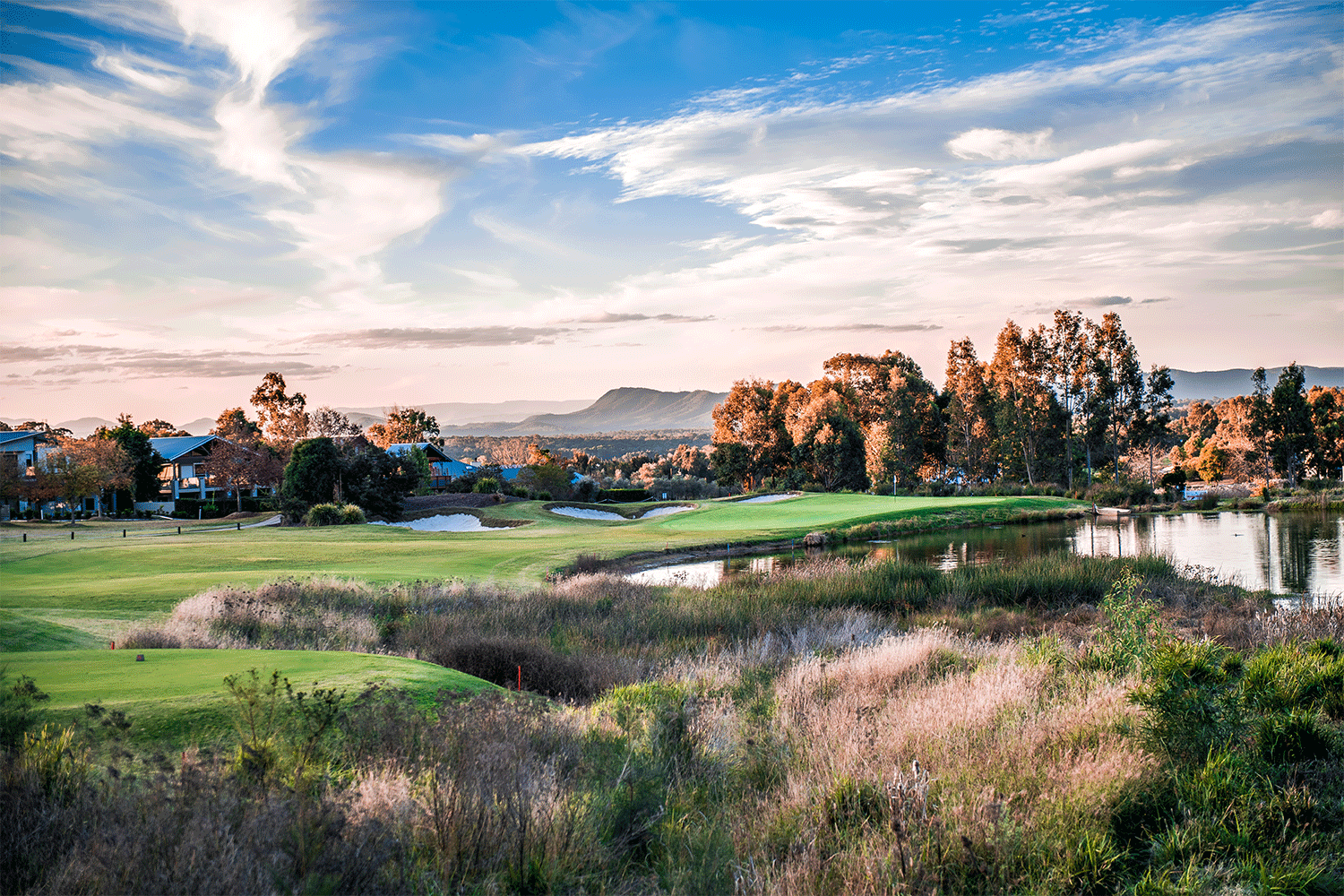Much doom and gloom has surrounded the Australian real estate market over the past year as figures indicate Sydney and Melbourne suffered a downturn in property prices. One dire prediction was for a 40 percent drop in home values over the next 12 months.
Certainly, the Australian property market has weakened with four of the eight capital cities reporting a drop in dwelling values. Sydney property peaked in July 2017 while Melbourne hit its zenith in November 2017, according to analysis by CoreLogic.
 However, demand is still strong for well-presented homes in popular suburbs as well as on the outskirts of major cities where homes are more affordable. And significantly, property prices in residential golf communities appear to be defying the downward trend.
However, demand is still strong for well-presented homes in popular suburbs as well as on the outskirts of major cities where homes are more affordable. And significantly, property prices in residential golf communities appear to be defying the downward trend.
“Regardless of market conditions, quality housing stock always sells,” says Ray Ellis, chief executive of First National Real Estate. “Houses or apartments attached to golf courses present the ideal living for not only golfers but for those who want literally acres and acres of gardens and wonderful views. This places living on the fairway squarely in – living the Australian dream.”
‘Houses or apartments attached to golf courses present the ideal living for not only golfers but for those who want literally
acres and acres of gardens and wonderful views’
– Ray Ellis, First National Real Estate
Sanctuary Lakes Resort at Point Cook, about 20 kilometres west of the Melbourne CBD, has experienced remarkable growth recently. The master-planned community – where Greg Norman designed a championship-length course – was the best performing suburban area in all of Australia earlier this year. According to data from CoreLogic, the median sales price for a house in Sanctuary Lakes was $660,000, which represented a change in median sales price of 48.3 percent. (CoreLogic analysed all properties in suburbs with a minimum of 40 sales in the 12 months through May 2018.)

Established in 2000, Sanctuary Lakes is now fully matured with approximately 10,000 residents and 3,000 homes on the site of the former Cheetham Salt Works. Facilities include a recreation club with gymnasium, swimming pool and tennis courts as well as back-to-base security and 24/7 mobile security patrols. The resort maintains the presentation of gardens and community areas.
The Sanctuary Lakes golf club became member-owned in 2014 and the entire development by Links Living is cited as a benchmark in Australia for major residential estates with a golf course
(1,000-plus homes).
In 2007 at Sanctuary Lakes, traditional lots were selling from $184,000 for 400m2 blocks to about $300,000 for 700m2. Waterfront land was priced between $355,000 (545m2) and $540,000 (900m2). House-and-land packages ranged from $460,000 to in excess of $700,000.
Following the arrival of Sanctuary Lakes, the suburb of Point Cook has undergone rapid population growth – from 33,431 to 60,901 people in the past seven years. It is forecast to increase by a further 30.4 percent by 2041. In terms of demographics, more than 21 percent of Point Cook’s population is less than nine years of age. And 63 per cent of families have children, compared to 46 percent across Victoria.

Strong demand has continued at Magenta Shores on the New South Wales Central Coast where a Ross Watson course is ranked No.22 in the country. A contemporary interpretation of beachside living is the theme at Magenta where residents have access to all of the facilities at the 5-star Accor Pullman Resort, including five swimming pools, tennis courts, gymnasium, heated pool and steam room.
In the past year, Magenta released 21 beach homes, incorporating the unique architectural feature of a ‘Roof Top Terrace’ overlooking the Pacific Ocean to the east. To date, 17 lots have sold off plan as house-and-land packages from $1.4 million up to $2.2 million for three-storey homes.
Two-storey, four-bedroom beach homes are currently priced from $1,428,000. And there is still an opportunity to purchase a three-storey home with the capacity for dual occupancy. That is, live in a four-bedroom penthouse with a two-bedroom apartment on the ground floor – effectively two homes for the price of about $2 million.
“This stage of development has been very exciting with continued strong interest and no drop in the market,” says Geoff Hallam, principal of Magenta Realty.
Meanwhile, 30 townhouses released last year at Magenta have all sold off plan prior to construction. Prices fetched up to $895,000 for the three-bedroom townhouses, which have a completion date of early to mid-2019.

Now in its 15th year of development, The Vintage at Pokolbin in the NSW Hunter Valley is approaching maturity with more than 400 completed homes. New land is for sale while three-bedroom houses start from $769,000 in a community that boasts a championship layout by Greg Norman and 250 vineyards in the surrounding region.
“Our most recent release of 51 lots of land in the Figtrees precinct sold so swiftly we have now extended this by another eight lots to meet demand,” says Robert Brooks, Vintage Realty’s sales and marketing manager.
The newest land release for 2019 is The Oaks precinct, which will reflect a slightly more exclusive approach, being a secure gated precinct of only 18 lots, with a private central parkland and
water feature. The Oaks will only allow individual architecturally designed residences to be built, ensuring a high property vale for owners.
“This combined with the new Pavilions At The Vintage entertainment precinct (now under construction) clearly shows the destination’s future is now offering more to residents than ever before,” Brooks says.
But it’s not all positive news. Living on the fairway will be a thing of the past for residents at North Lakes, the Brisbane community with more than 6,500 homes. North Lakes Resort Golf Club is scheduled to close in late 2019 after the owner announced plans to sell the course and have it turned into a retirement village and aged-care facility. However, about 85 percent of the course will be maintained as publicly accessible open space with a range of sport and recreational uses.

After trying to offload the golf club to another course operator for more than two years, Adam Simpson decided to close the Graham Marsh layout. Simpson told Brisbane’s Courier-Mail a lack of revenue from golfers made the business unviable. Simpson purchased North Lakes in 2006 and had made a profit for several years until income declined steadily from social players and corporate golf. Compounding matters, the club also needs major capital expenditure on existing facilities and equipment.
Trend
More clubs considering land redevelopment
Residential golf communities like Sanctuary Lakes have attracted golfers and non-golfers because of the desirable aspects of ‘Living On The Fairway’. But given the huge cost and unavailability of large parcels of land near urban areas, it’s unlikely there will be too many more residential golf developments in the foreseeable future.
Increasingly, we’re seeing privately owned golf clubs in Sydney, Melbourne, Brisbane and Canberra seeking to secure their future by selling off a portion of their course to fund course renovations, clubhouse refurbishments and/or pay off debt. Clubs see this as a viable option if they’re unable to raise alternative capital from operational profits, levies or entrance fees.
Strathfield Golf Club, just three kilometres from Sydney Olympic Park, has ventured down this path. The 120-year-old club sold off a strip of land where the practice range, car park and old clubhouse were located. Brisbane-based Metro Property Development paid $52.5 million for the 2.2 hectares on the eastern side of Centenary Drive. Metro Property built 50 townhouses overlooking the new par-3 16th and 17th tee where the practice range used to be. Prices for two to four-bedroom homes at Parvenu fetched between $1.75 and $2.2 million.
The rest of the land (car park and clubhouse) has since been on-sold to Conquest, which has submitted planning approvals for about 180 apartments in two nine-storey residential towers. The Greens Strathfield is likely to be highly sought after given the central location as well as the close proximity to some of the finest private schools in metropolitan Sydney. The Greens will set a benchmark for luxurious ‘resort style’ living on the fringe of Sydney’s inner-west and represents outstanding value for first homebuyers and investors.
Meanwhile, the financial windfall has allowed Strathfield Golf Club to retire a $2 million debt, fund the construction of a relocated three-storey clubhouse at a cost of $23 million and commission James Wilcher to renovate the course to the tune of $6 million. The club has reinvested the remaining proceeds.
Elsewhere, Aura Holdings has negotiated to build retirement villages at two of Queensland’s best-known clubs. At Indooroopilly Golf Club, seven kilometres from Brisbane’s CBD, Aura will construct approximately 220 retirement living apartments in four buildings of five storeys. The lease of 2.5 hectares of freehold land (1.9 percent of club land) is set to deliver huge benefits at the 36-hole facility that had its origins in 1925.

In a document titled ‘Securing the club’s future’, Indooroopilly revealed Aura would deliver an upfront payment of $22.127 million, provide ongoing annual income, reconfigure nine holes and provide 40 percent more water for irrigation. Total income over 40 years is projected to be $76 million. That means the club will be able to improve both courses through increased maintenance and new design, restore its financial position following 2011 flood repairs, attract new members and fund clubhouse refurbishments.
Members at Toowoomba Golf Club have welcomed council approval for Aura Holdings to build a $30 million retirement village consisting of 78 apartments in three towers up to four storeys high. Established in 1896, the club had been considering options to secure its long-term viability. The development will give the club more than $3 million to enable the improvement of existing facilities.
In Canberra, Yowani Country Club has also unveiled plans to redevelop part of its golf course in what’s been described as a “once-in-a-generation opportunity to redefine the club”. Enduring a fall in gaming revenue and declining support for golf and bowls, Yowani is aiming to secure its future with a residential development. A rezoning application has been lodged, which the club is very confident of gaining approval. However, Yowani hasn’t made any definitive plans with the developer and is in consultation with the community about what the development will include.
One Club’s Dilemma
take action or perish
Eight years ago Brighton Lakes was all but a pipe dream. Back then the former New Brighton Golf Club on the banks of the Georges River at Moorebank in western Sydney was in dire straits. Its future was so bleak members voted to investigate how to save the 90-year-old club that had its origins near Sydney Airport.

Immediate past president Ray Wood was instrumental in finding a solution to the predicament that eventually saw developer Mirvac come to the club’s rescue. Mirvac entered into a complex Project Delivery Agreement (PDA) with the golf club and a land transfer agreement with Liverpool Council that would help with its vision of opening up the Georges River foreshore for public use.
Mirvac developed the Brighton Lakes estate on the land adjoining the existing residential areas of Moorebank and Georges Fair that previously comprised the New Brighton clubhouse, first, ninth, 10th and 18th holes. The 306-lot masterplan is a mix of freestanding single and double-storey homes, townhouses and Fonzie-style two-bedroom strata apartments. Brighton Lakes has 3.1km of cycleways and 2.6km of footpaths. Residents have exclusive use of a community green with a swimming pool, tennis court, barbecue, playground and grass kick-around area.
Brighton Lakes attracted unprecedented demand for the 306 homes with more than 8,000 registrations of interest. Sales commenced in mid to late 2015 and sold progressively off plan over the next couple of years. Homes at Brighton Lakes were priced from $529,900 for a two-bedroom apartment up to $1,245,900 for a premium five-bedroom home overlooking the golf course, with an average price of approximately $838,000.
Meanwhile, the club rebranded as Brighton Lakes Recreation And Golf Club. Through the PDA, it was able to build a new 4,500m2 clubhouse with restaurant areas, gaming and sports bar lounge, function rooms, pro shop and café. In addition, it covered the cost of course improvements necessitated by the residential development. Bob Harrison is responsible for the redesign, which has relocated seven holes to the southern side of the M5 Motorway on land previously occupied by the historic Greenwood golf course. Once completed in April 2019, Brighton Lakes will be a contender for Australia’s Top 100 Courses.
Hence, it’s a win-win-win for all parties – golf club, residents and developer. Paul Nichols, general manager of Brighton Lakes Recreation And Golf Club, says it’s been a remarkable transformation from the working-class area where he grew up. Moorebank was mostly industrial land with minimal housing and the Boral brick quarry occupied 103 hectares on Nuwarra Rd from 1951 to the early 1990s. Further afield was the army barracks at Holsworthy.
Young families and downsizers are the two core demographics that have moved into Brighton Lakes, according to Nichols. “People who have raised their families at Chipping Norton and Moorebank have got to the point where they don’t want the maintenance anymore – sell off and move into a smaller footprint with less maintenance but with modern facilities they never had.”
With dining, entertainment and conference facilities, the three-storey golf clubhouse is widely used by Brighton Lakes residents and the broader community. “It’s the Taj Mahal,” Nichols says. “It’s state of the art and what it’s done has brought some real prestige to the area – along with the quality of the development and quality of the homes. It’s brought a lot of good money into the area.”
“It’s state of the art and what it’s done has brought
some real prestige to the area – along with the quality
of the development and quality of the homes”
– Paul Nichols, Brighton Lakes
First homebuyers Simon and Sarah Mansour spent their first Christmas at Brighton Lakes in 2016. Reflecting on what they love most about living there, Simon says: “The best thing is waking up in the morning with a cup of tea, looking out the bedroom window to watch the sun rise. And then going for a walk around the neighbourhood and picking up a coffee from the golf club café. We also love being able to walk to the golf club and invite friends and family to join us for dinner overlooking the golf course.”
Such is the success of Brighton Lakes that Mirvac recently collected two major gongs from the 2018 UDIA NSW Crown Group Award for Excellence where Brighton Lakes won best Greenfield Development and best Sustainable & Environmental Technology.
Not Slowing Down In Retirement
Living next to the rolling fairways of Castle Hill Country Club has more than a few perks for Brian Hoare, Lloyd Taylor, Gavin Cobcroft and Ross Hogan. All long-time golfers, they only recently became playing partners after discovering their shared interest as neighbours at Cranbrook Residences in Sydney’s north-west.
All four appreciate the easy access to a Top 100 golf course as well as having plenty of time to practise in retirement now they don’t need to maintain the family home.
“There’s nothing better than waking up, checking the weather from my balcony, wandering over to the course to have a round with a neighbour, then coming back home for a social post-game catch-up,” says Hogan.
Cranbrook Residences is much more than a room with a view. Facilities include a new cinema, library, the Reflections wellness centre as well as a café, outdoor barbecue and entertaining areas. However, it’s been the opportunity to maintain an active lifestyle that appeals to residents.
“While our golf-friendly location has been a major drawcard for some residents,” says Cranbrook Care chief executive Kerry Mann, “others have discovered the sport since moving in and are loving learning the game, meeting new people and keeping fit – and not just on the golf course.
“Our residents are turning the idea of slowing down in retirement on its head, with many hitting the gym and taking up fitness classes for the first time in years, if not ever, thanks to the social nature of our activities, and the confidence gained by taking up new pursuits with like-minded peers.”



